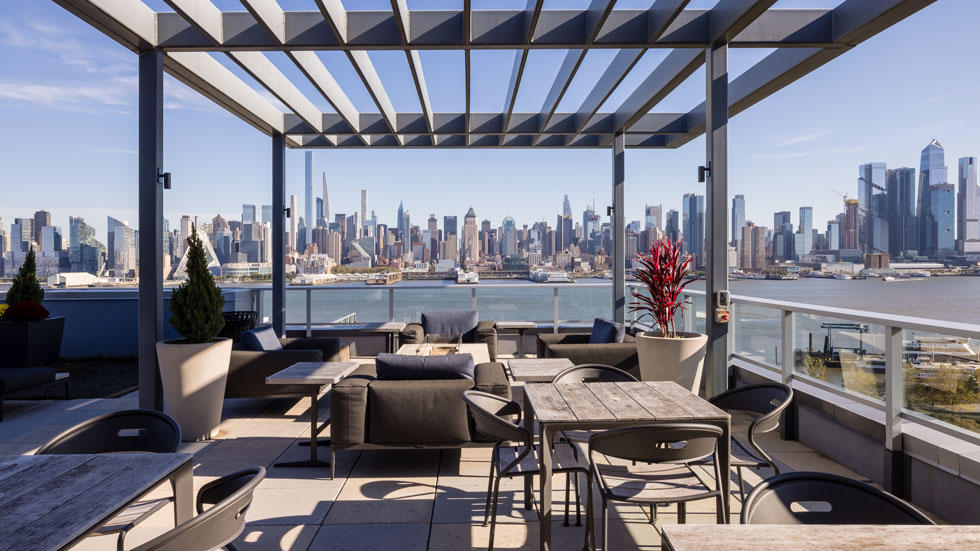Rebranded Veris Residential embarks on its new strategic direction as a pure-play multifamily REIT.
Veris Residential, Inc. (NYSE: VRE), formerly Mack-Cali Realty Corp., has shed office assets, paid down debt, and streamlined operations in order to clearly define its new strategic focus on the Class A multifamily sector.
After decades focused on office, multifamily, and assorted other property types along the New Jersey waterfront and beyond, the REIT rebranded to Veris Residential in December under the leadership of CEO Mahbod Nia.
The Jersey City-based REIT currently owns 21 Class A multifamily assets totaling 6,691 units in New Jersey, New York, Boston, and Washington, D.C., and it is now considering how to expand the portfolio and maximize shareholder value.
Efforts to shrink the office footprint and build up its small base of apartments had been underway for some time at the former Mack-Cali following its acquisition of Roseland Residential Trust. However, its execution of that strategy, along with high debt and lagging financial performance touched off two proxy battles with activist investor Bow Street, which wanted to split the REIT into two companies.
The contests eventually resulted in a reconstituted board and management in 2020 to hasten the transformation to a pure-play multifamily REIT. Then, in March 2021, Nia took over as CEO to complete the job and move the company forward.
“In the past there had been so many changes in leadership and so much uncertainty with the proxy contests that it was very difficult to have clarity as either an investor or, candidly, an employee,” says Nia, who replaced MaryAnne Gilmartin, a real estate veteran who accepted the interim CEO role in 2020.
“We have stability now. Having a clear direction and a clear strategic vision has been hugely motivating and has helped us become a more investable REIT,” Nia says.
‘Totally Different Company’
To simplify and de-leverage the business, over the last few years the company has sold more than 30 suburban office assets for over $1 billion, and it recently contracted to sell two waterfront office properties for $590 million. Veris has used the proceeds to pay off $575 million in bonds coming to term in 2022 and 2023, reducing its total debt to $2.4 billion.
At the same time, it has beefed up its apartment occupancy to 96.4%, a level that bested the pre-pandemic rate by 2.8 percentage points. Veris also anticipates $5 million annual cash expense savings from streamlining its organization and processes. It has also launched an ambitious environmental, sustainability, and governance (ESG) program.
With those maneuvers, Veris’ multifamily portfolio represented about 56% of its net operating income (NOI) at the end of 2021, up from 38% in 2020, and is expected to rise to 71% following two office assets under contract, one of which closed in January.
“Veris has executed very well over the last year, and they’ve put a lot of their hardest challenges behind them,” says Thomas Catherwood, managing director of REITs equity research with BTIG. “From this point going forward, it’s not just a different name and different strategy, it’s a totally different company.”
But the full transition is not quite complete. Veris still owns a handful of office and retail assets in its Jersey City Harborside mixed-use project, as well as a smattering of hotel, garage, and one suburban office asset in New Jersey. While Veris decides when and how best to dispose of those, it also must determine how to optimize a land bank across New Jersey, New York, and Boston. All told, the land could accommodate 8,400 apartment units spread across 14 development sites, although as of the end of February Veris had six land parcels under binding contracts.
Land Bank Misconceptions
Veris’ latest apartment development, the 750-unit Haus 25 in Jersey City, is scheduled to open in the second quarter of 2022. Beyond that project, Veris has no immediate development plans. It could take eight to 10 years to fully develop its land bank, but the company is hardly in the position to tie up capital that long, says Nia, who started and ran NorthStar Realty Europe from 2015 to 2019. He would rather recycle this capital to acquire operating assets that are generating income on the first day Veris takes possession, to repay debt, or to return capital to investors.
“The one misconception is that the land bank is ready to develop now—it’s not,” Nia says. “It’s at various stages of being entitled, and it’s fully funded by equity, which is creating a drag on earnings. So, while we’ve stored land for the future, we don’t have the capital to develop it. And I would argue that we don’t really have the time.”
Given that the vast majority of the land is in the New Jersey markets of Jersey City, Weehawken, and West New York, development would also create concentration risk, Nia adds. For those reasons, selling land and directing the proceeds toward multifamily acquisitions is a sensible strategy that ultimately could contribute to adjusted funds from operations (AFFO) and help the REIT reinstate its dividend, which was suspended in the third quarter of 2020, he says.
“If we can monetize some of the land and buy assets, even at a the current capitalization rate, there would be a reasonable expectation that the properties would get due recognition in the public markets,” Nia says. “It’s easier to value a standing multifamily asset than it is land.”
Nia’s reference to capitalization rate compression speaks to the competition for multifamily properties, especially for new Class A assets in major markets. In the Northeast, for example, the average apartment cap rate fell 87 basis points to 4.97% in the third quarter of 2021 from a year earlier, according to CBRE. In Boston, however, cap rates for infill multifamily properties were even lower, ranging from 3.25% to 3.75% in the first half of 2021, CBRE reports.
Despite the multifamily market’s frothiness, swapping development land for operating assets makes the most sense if Veris wants to quickly impact its portfolio, says Anthony Paolone, an executive director and REIT analyst with JP Morgan.
“We’re in an environment where nobody is stealing assets. You’re not selling land at a high price and buying operating assets at a low price,” Paolone says. “But at least you’re going from an asset that’s not producing income to one that is. That’s a better option for Veris right now.”
Seeking Optionality
Developing land is not the only way to generate alpha, and future strategies Veris could pursue may include asset conversion and the repositioning of assets, although no concrete plans have been determined, Nia says. The company would also consider funding operating partners to develop properties. What’s more, just as it wants to balance development with acquisitions, it is aiming for greater geographical equilibrium in the Northeast.
“I think there’s an imbalance when 80% of our assets are in New Jersey,” Nia states. “To the extent we develop or acquire more properties, should we stay there, or are there other markets where we have expertise and experience that would provide an investment proposition that’s equally compelling, if not more compelling? I think Boston is an obvious one.”
Veris’ above-average debt level and over $1.5 billion market capitalization are conspicuous in a sector that is dominated by larger and more mature peers, however. In the short-term, that may make it more difficult to meaningfully build its portfolio through acquisitions, Paolone says.
The REIT’s debt-to-EBITDA multiple of 15.3x at the end of the fourth quarter of 2021, was well above the industry average of around 5x, according to Green Street. Still, other characteristics make the REIT a possible buyout target, and Green Street estimates that such an event has a 60% chance of occurring over the next 18 months. The company is far more attractive now that it has all but jettisoned its office business, Green Street notes, and its share price is trading at roughly 30% discount to net asset value (NAV).
“The potential for a takeout certainly exits,” Paolone acknowledges. “The old portfolio of suburban office, waterfront office, and residential appealed to three different investor types, and running a sale a year or so ago would have been very challenging. But as a company and a board, if they’re trying to maximize value, they’re going down a path that gives them optionality.”
In response to a question about a potential sale, Nia stresses that management’s goal is to drive value for its stakeholders and build a “best-in-class” REIT. That doesn’t preclude the board from exercising its fiduciary duty to evaluate ways to maximize shareholder value, he adds.
ESG at the Core
In many ways, Nia’s four-and-a-half years leading NorthStar Realty Europe prepared him for his present role. The company, which was spun out of NorthStar Realty Finance, was similar to Mack-Cali in complexity, with a $2.6 billion portfolio comprising five different asset classes in nine countries and high debt and G&A expenses compared to its peers.
Nia spearheaded an effort to pare its debt and G&A expenses while simultaneously leasing up and pruning its portfolio to focus on Class A office buildings. Those actions, along with slimming its geography to three countries, fueled a 40% increase in per-share NAV. In 2019, AXA Investment Managers—Real Assets bought the company resulting in a 16% internal rate of return (IRR) for shareholders.
After the sale, Nia began envisioning creating a real estate platform that featured ESG at its core, particularly because the built environment contributes 40% of global carbon emissions. After Nia joined Mack-Cali’s refreshed board in 2020 at the behest of Bow Street, ESG became a key priority in light of the company’s poor ratings on ESG issues by Institutional Shareholder Services.
The new board spearheaded actions that quickly improved the ratings. Later, in conjunction with the official rebranding, Nia introduced Embrace by Veris, a program designed to fashion the REIT into an environmentally and socially conscious owner, operator, and developer of high-quality apartment properties across the Northeast.
“Climate change is a current reality, not a future threat, and as a whole, the real estate sector has been very slow to react and hasn’t taken responsibility for its role in the environment,” he says. “That may be an inconvenient reality for current real estate managers who are solely focused on financial returns. But we believe we can better position ourselves to generate long-term shareholder value by identifying the risks and opportunities presented by ESG considerations, without necessarily compromising shareholder returns.”
Broadly speaking, Embrace is focused on creating communities that are in alignment with the sustainable values of Veris and its residents, creating a diverse and inclusive workplace that attracts and retains top talent, and evaluating how development and operating decisions impact the environment as part of a commitment to reduce Veris’ overall carbon footprint.
A growing number of REITs are pursuing ESG strategies, but Veris is taking a stronger and more vocal stance than others, according to Catherwood. At this point, it’s hard to quantify whether ESG commitments have more influence on performance than a newly constructed building or its location, he adds, but REITs that own properties with best-in-class energy-management, environmental, and operating practices tend to maintain higher demand, occupancy levels, and rental rates than the market average.
“I think it’s fair to say that the market and investors are definitely placing a bigger focus on ESG today than 18 months to two years ago,” Catherwood says. “So for Veris to make this a cornerstone of its strategy is the right move. It helps elevate the company’s status and draws a lot of attention, which is good business when it comes to differentiating yourself from others.”




